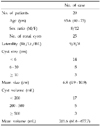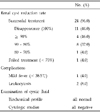INTRODUCTION
Simple renal cysts involve the cylindrical epithelium and are histologically benign.1 They are quite common and usual incidental findings in elderly patients. In one study, incidence at 40 and 60 years was reported at 20% and 33%, respectively.2
Simple renal cysts are usually clinically silent and do not require treatment, however, can be associated with flank pain, hypertension, hematuria, and collecting system obstruction. When symptoms and/or urinary tract obstruction is detected, a treatment modality should be considered. Symptomatic renal cysts can be managed by a variety of surgical and percutaneous methods, including percutaneous aspiration (with or without sclerosing agent), percutaneous marsupialization, and open and laparoscopic cyst unroofing.3-8 Percutaneous drainage with single or multiple-session sclerotherapy has been successfully performed with high success rates. However, in terms of recurrence, better results have been reported with multiple-session sclerotherapy.1,5,9-12
MATERIALS AND METHODS
Twenty patients (8 male, 12 female) with 25 simple cysts underwent percutaneous sclerotherapy treatment between October 2005 and February 2006. The study was performed on patients with flank pain, dyspepsia, other related symptoms, or cyst size greater than 4cm. Symptomatic cysts occurred in 6 patients (30.0%) and large sized cysts in 14 (70.0%). All cysts were type I Bosniak cysts.15 Location was right, left, or bilateral sided in 9, 8, and 8 kidneys, respectively. Mean age was 63.6 (range 40-73) years (Table 1). Baseline ultrasound (US) or CT scan was obtained on all patients; cyst dimensions were measured to calculate initial volume prior to treatment. Detailed information on presence and severity of symptoms was collected. Complaints and blood pressures were closely documented before and after treatment.
Procedures were performed by US and fluoroscopy guidance on a 1 day inpatient basis. Patients were placed prone and cyst location confirmed by US. Puncture site was selected and infiltrated with Lidocaine; 18 G puncture needle under US guidance was used for initial cyst puncture. The first 10mL of aspirate was sent for cytological and biochemical examination. Subsequently, all fluid was aspirated and 0.1 mg of OK-432 per 10 mL of cystic fluid was administered. Maximum injected volume was 1 mg.
Patients were evaluated after 3 months by clinical assessment, US, or CT scan. Success was defined as complete or partial when there was total ablation or greater than 70% reduction with resolution of symptoms, respectively. Failure was defined as less than 70% reduction and/or persistent symptoms.
RESULTS
Mean cyst size was 6.8cm (4.9-10.9cm) (Table 1). Average reduction was 93.0%. 11 (44.0%) cysts showed complete resolution (Fig. 1) and 13 (52.0%) had partial resolution (Table 2). One case was defined as failure, with 64.2% size reduction from 10.9cm to 3.9cm (volume reduction rate 95.4%). No cyst had malignant cells on cytological examination. Renal pain improved in all patients, regardless of complete or partial resolution.
Minor complications occurred in 3 patients, 2 developed leukocytosis and 1 had mild fever (< 38.5℃) the first few days after aspiration and sclerotherapy. Patietns were treated successfully by conservative measures and NSIAD therapy.
DISCUSSION
With new advances in endourology and interventional radiology, attractive alternatives to open surgery have been suggested for treatment of simple renal cysts. Appropriate procedure selection depends on clinical goal in addition to considerations of patient safety, comfort, and cost.
Simple drainage without sclerotherapy is associated with recurrence of 30-80%.5,16 The percutaneous approach with a sclerosing agent provides more satisfactory results than aspiration alone, where fluid almost always re-accumulates because of a viable cyst wall.5,17 Several sclerosing agents including ethanol, glucose, phenol, chloro-hydrolactate, pentopaque, acetic acid, povidone iodine, tetracycline, bismuth phosphate, and ethanolamine oleate have been used to injure the epithelial cells of the wall.1,5,6,18-22 Ethanol has been commonly used for hepatic cysts, hydatid cyst, and lymphoceles.23-25 As ethanol penetrates the fibrous capsule after 4-12h, epithelial cells lining the cyst may be completely destroyed without damaging adjacent renal parenchyma.25
However, current reports suggest lower rates of 10-68% complete resolution with 1 alcohol injection.5,6,22 The difference between early and recent reports may be attributed to longer follow-up in recent studies. However, several current studies showed improved results in modified alcohol sclerotherapy. Complete cyst resolution improved to 73-100% when injection was repeated 2 or more times over several days.6,8,16 Others reported good results using continual 24h cyst drainage by pigtail catheter, either before or after 1 injection.5,10 Also, prolonged cyst wall contact with alcohol was reported to produce better results.11,26
OK-432 is a lyophilized mixture of a low virulence Su strain of Streptococcus pyogenes which has been incubated with penicillin G (Chugai Pharmaceuticals Co, Tokyo, Japan).27 Injection of OK-432 into lymphangioma cyst immediately evokes inflammation and infiltration of inflammatory cells (including neutrophils and macrophages) causing extensive production of IL-6.27 Intralesional injection has been reported as an alternative treatment for Iymphangiomas and cystic hygromas.13,27 In addition, intracavitary injection in patients with malignant pleural or peritoneal effusion has resulted in resolution in approximately 90% of patients.27,28
In our preliminary data, 24 of the 25 renal cysts had complete or partial resolution after OK-432 sclerosing therapy. No significant complications were observed in follow up.
Many define success as reduction greater than 50% original cyst volume and failure as recurrence of greater than 50% volume. However, we defined success as reduction greater than 70% original size and failure as recurrence greater than 30%. Volume reduction is more wide difference changes than size reduction. Our results were very effective, we therefore chose size reduction rather than volume reduction in our definition. We experienced failure in 1 case, however if we had used volume reduction rate, our failure case would be defined a success.
In conclusion, we have shown that single-session OK-432 sclerotherapy is a safe, effective, well-tolerated, and minimally invasive procedure for management of simple renal cysts and has a low recurrence rate comparable to other forms of sclerotherapy.




 PDF
PDF ePub
ePub Citation
Citation Print
Print





 XML Download
XML Download